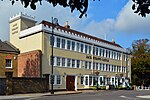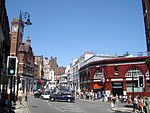Upper Flask
Buildings and structures in HampsteadFormer pubs in LondonPubs in the London Borough of CamdenSpas

The Upper Flask was a tavern near the top of Hampstead hill in the 18th century which sold flasks of water from the Hampstead spa. It was the summer meeting place of the great literary and political figures of the Kit-Kat Club such as Walpole. The tavern business ceased in the 1750s and the grand house subsequently became the private residence of ladies and gentlemen such as Lady Charlotte Rich, George Steevens and Thomas Sheppard.
Excerpt from the Wikipedia article Upper Flask (License: CC BY-SA 3.0, Authors, Images).Upper Flask
Holford Road, London West Hampstead (London Borough of Camden)
Geographical coordinates (GPS) Address Nearby Places Show on map
Geographical coordinates (GPS)
| Latitude | Longitude |
|---|---|
| N 51.5607 ° | E -0.1788 ° |
Address
Queen Mary's House
Holford Road
NW3 1DU London, West Hampstead (London Borough of Camden)
England, United Kingdom
Open on Google Maps










